On the centenary of the plant named after Degtyaryov: from the machine gun Madsen to KORD. Part of 4
In total, during the war years, the plant released and handed to the howling at the front of the 1 units a million 202 thousands of 481 units. At the same time, employees of the enterprise fought with the enemy on all fronts of the Great Patriotic War, more than a thousand factory workers never returned from the battlefields. September 16 1945 was awarded the Order of Lenin for the successful fulfillment of the tasks of the State Defense Committee - State Defense Committee for the provision of the Red Army with infantry and small arms. In this work on the creation of new types of automatic weapons did not stop here for a minute. In the postwar years, the plant is constantly developing new products. The new machine gun, launched into serial production, was the RPD, the Degtyarev system's light machine gun, in service with the Soviet Army until the middle of the 1960s. [/ justify]
Already at the end of 1943, work on the development of light machine guns for the new intermediate cartridge 7,62x39 mm began in the USSR. The field tests conducted have demonstrated that the destructive power of the bullets of such cartridges and the accuracy of their combat are satisfactory at a distance of up to 800 meters. As shown by combat experience, this range for light machine guns was quite enough. Famous designers Simonov, Sudayev, Degtyarev and others took part in the design of the new Soviet light machine guns.
In 1944, on the ongoing competitive trials, the light machine gun, proposed by Degtyarev, pulled out ahead; the machine gun was known under the designation RD-44. Until the end of World War II, this light machine gun was made in a small series, which passed military tests. Soon after the end of the war, a modernized version of the machine gun was adopted by the Soviet Army under the designation RPD, the Degtyaryov light machine gun. It is worth noting that the RPD was one of the first officially adopted for use weapons of small arms for the new intermediate cartridge model 1943 of the year. The first prototype RPD light machine guns had separate cartridge boxes with tape, but over time, preference was given to the box that was attached directly to the machine gun: it solved the problem of increasing the weapon’s rate of fire while maintaining combat readiness and maneuverability. The ammunition box was always with a manual machine gun, and a machine gunner in a battle could quickly change position and open fire on the enemy without the help of the second number of the calculation.
RPD is an automatic small arms with a gas engine automation and band power. The work of automatic machine gun was based on the use of the energy of powder gases, which are discharged from the barrel. When firing a weapon, a part of the powder gases ejecting a bullet is directed through a special hole in the barrel wall into the gas chamber and presses against the front wall of the gas piston, throwing the piston together with the slide frame and the bolt into the rear position. After that, the shutter opens the barrel bore, and the slide frame compresses the return-combat spring. The liner is removed from the chamber and is then thrown out. The feed mechanism advances the belt forward and delivers a new cartridge that is installed opposite the longitudinal shape receiver window.
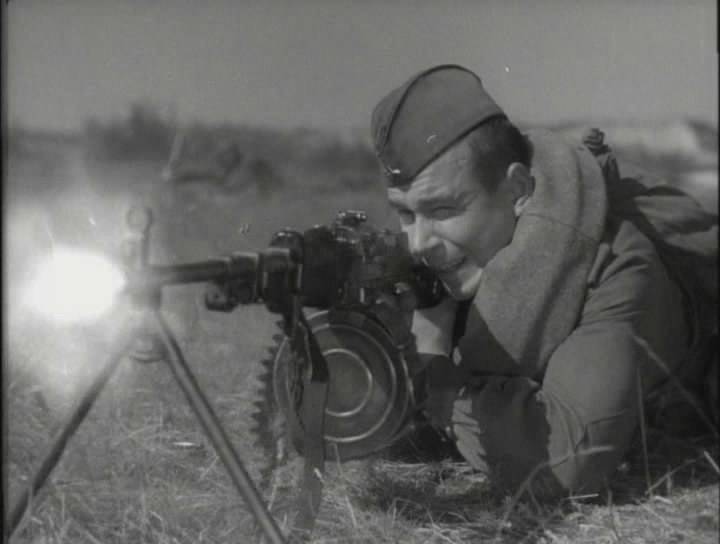
Instead of the store supply, which was used on the DP and PDM series machine guns, the new RPD machine gun was switched to tape feed. The power of the machine gun was carried out from non-bulk metal tape, designed for 100 cartridges. The tape consisted of two identical pieces of 50 cartridges each. Curb tape was located in a round box (box), which is adjacent to the bottom of the machine gun. The choice of such a design provided the machine gun with good mobility (the tape overhang was excluded) and the increased combat rate of fire.
It is worth noting that the RPD was the first machine-powered tape-powered machine gun in the Soviet Union (if you do not take into account the remake machine gun of the Maxim-Tokarev system). The use of the ribbon machine in the new light machine gun was largely due to the influence of the successful use of such a power scheme by the Germans, in particular in the uniform machine guns MG-34 and MG-42, which were widely used by the German infantry throughout the war. The tape not only made it possible to increase the combat rate of fire of the weapon, but also to reduce the weight of a light machine gun with standard ammunition to acceptable values. An important point was also the fact that the tape feed system of cartridges excluded the presence of springs, which usually became the causes of delays in machine guns with the magazine supply system.
The sights of the RPD consisted of a sector sight, whose pitch was 50 meters at a distance of up to 1000 meters, and a fly with side protection, which was mounted on a holder. The length of the weapon's sighting line was 596 mm. The light machine gun turned out to be a fairly light and durable weapon; it also stood out for its reliability, accuracy and unpretentiousness. The machine gun did not need constant technical inspection and was easy to operate and maintain. Transported a light machine gun on a belt with a folded and fixed with the help of a spring on the barrel bipod. The version called RPDM (modernized) differed from the original model of the machine gun in the shape of the gas piston and support, and when firing the reload lever remained in the forward position, in the version of the RPD it was connected to the bolt.
In contrast to the DP line machine guns, the new RPD machine gun had an irremovable barrel. The experience of the combat use of such weapons has demonstrated that usually fire is fired in short bursts, and the barrel without replacement allows you to spend all wearable ammunition. A spare barrel would always have to be in machine-gun design, which led to the weighting of the entire system, moreover, the design itself of a light machine gun equipped with a replaceable barrel was less reliable and more complex.
[justify] RD-44 light machine guns and RPD are well ahead of their time. The idea of equipping infantry formations at the squad-platoon level with weapons only for an intermediate cartridge prevailed in the West only with their transition to low-impulse cartridges, which occurred in the 1960-1970's. At the same time, in Nazi Germany during the war years, the prospect of creating a light machine gun chambered for 7,92x33 mm was hardly worked out. In the Soviet Union, the RPD was one of the first models of small arms, specially created for the new intermediate cartridge 7,62х39 mm of the model 1943 of the year. From the beginning of the 1950-s and almost until the middle of the 1960-s, the FAP continued to remain the main support weapon at the branch level, and later began to be replaced in the army with the PKK, which was the preferred option in terms of unification. At the same time, RPD machine guns can still be found in army warehouses. Like many models of Soviet weapons of those years, the machine gun was widely exported, primarily to the friendly countries of the USSR, and also produced abroad, for example in China, under the designation Type 56.
As noted above, the shooting of the RPD machine gun was conducted with intermediate rounds of the 1943 model of the year. The arrows were available the following types of bullets: ordinary with a steel core, armor-piercing incendiary, incendiary and tracer. At the same time, the bullet maintained its killer effect at a distance of 1500 meters. The range of a direct shot from a weapon on a chest figure was equal to 365 meters. A machine gun fire on aerial targets could be conducted at a distance of up to 500 meters. The combat rate of fire of the RPD was up to 150 shots per minute, and maintaining intensive firing in bursts without cooling the barrel was possible before reaching the mark of 300 shots.
Performance characteristics of the RPD:
Caliber - 7,62 mm.
The cartridge - 7,62x39 mm.
Length - 1037 mm.
Barrel length - 520 mm.
Machine gun weight - 7,4 kg (with bipods and unfit tape), 9 kg (with curved tape).
Rate of Fire - 650-750 rds / min.
Combat Rate - 150 rds / min.
The initial speed of the bullet - 735 m / s.
Sighting range of shooting - 1000 m.
Effective firing range - 800 m.
Food - 100 tape on rounds in a metal box.
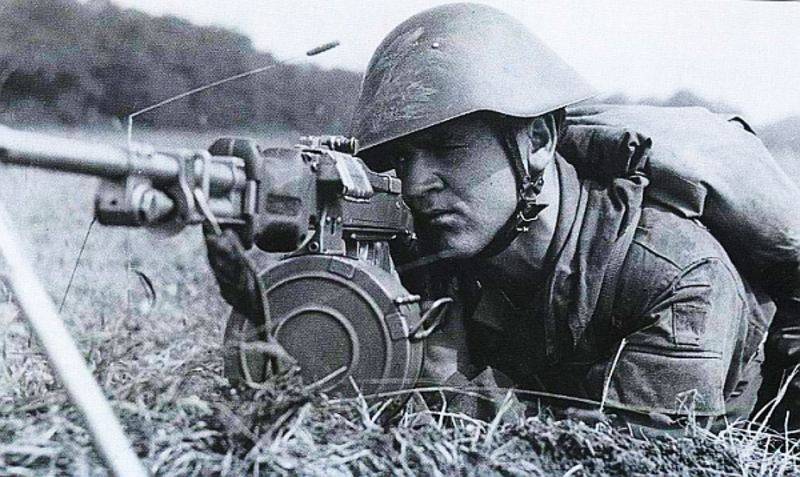
Information sources:
https://www.all4shooters.com/ru/strelba/osnovnye-novosti/K-100-letiyu-zavoda-imeni-V-A-Degtyareva-ot-Madsena-do-KORDa
http://www.zid.ru/company
http://world.guns.ru/machine/rus/degtyarov-rpd-r.html
http://rus-guns.com/pulemet-sistemy-degtyareva-rpd-obr-1944-g.html
Open source materials
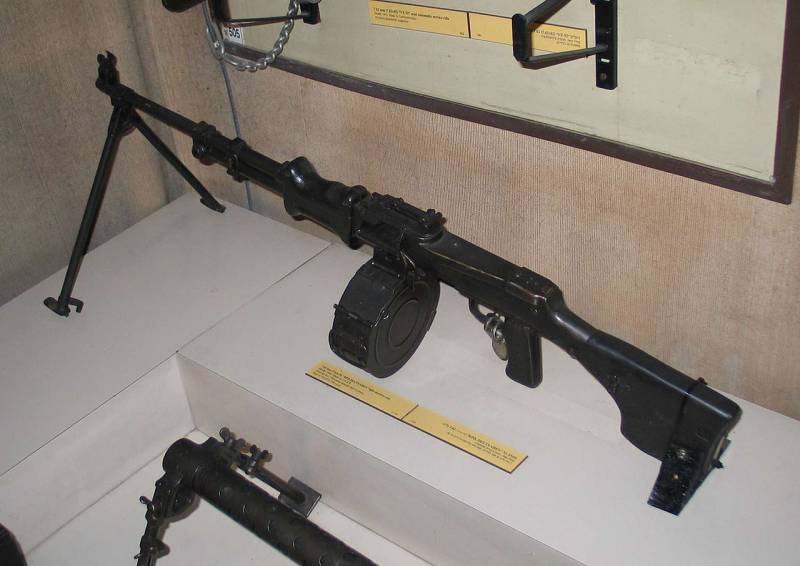
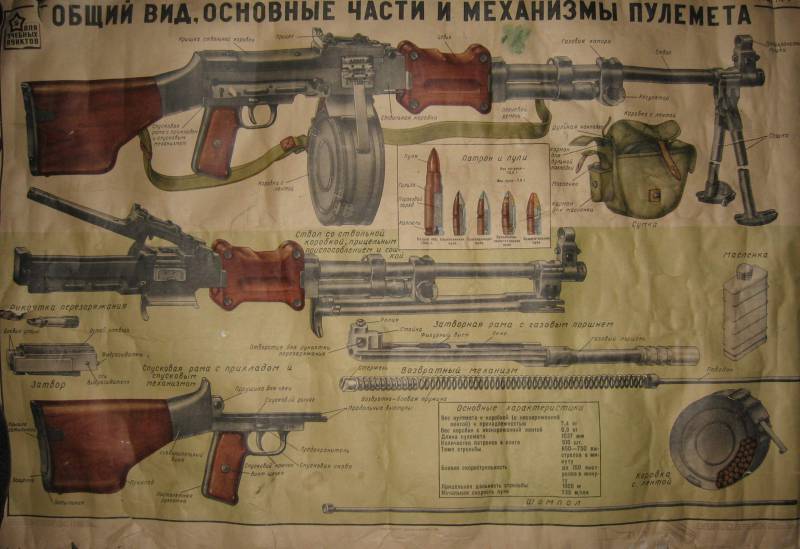
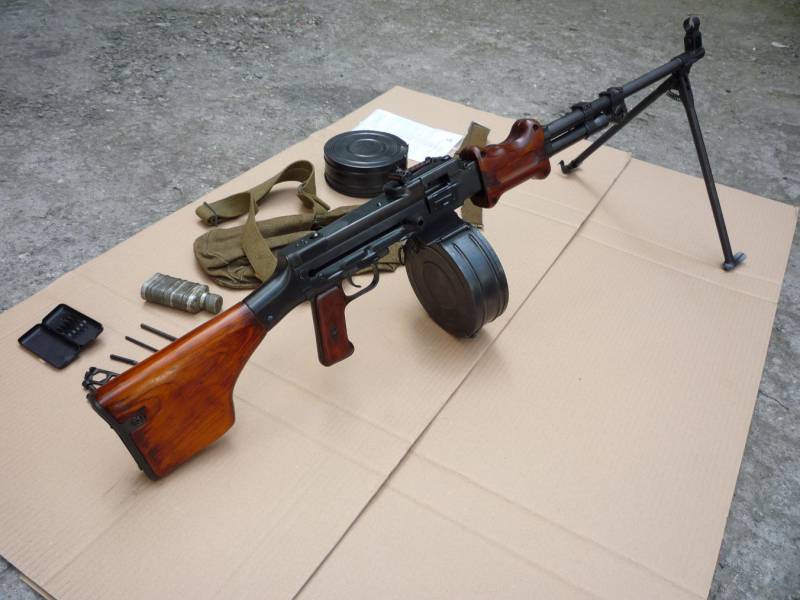
Information